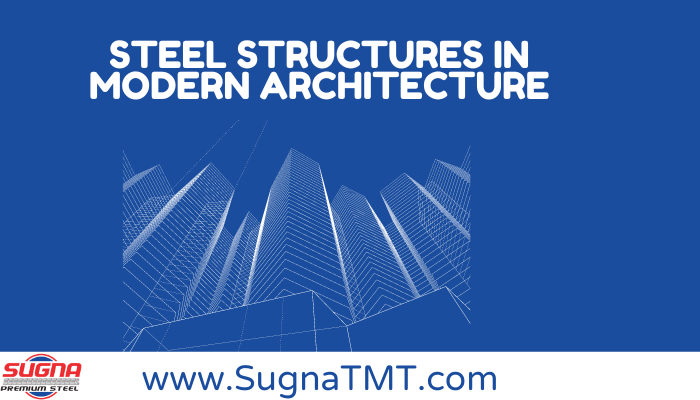Steel has become one of the most popular materials in modern architecture, transforming the way buildings are designed and constructed. Its versatility, strength, and durability make it an ideal choice for a wide range of structures, from skyscrapers to residential homes. As the construction industry continues to evolve, steel structures are playing a crucial role in shaping the future of architecture. In this blog post, we will explore the top five benefits of using steel structures in modern architecture and why they are increasingly favored by architects and builders alike.

1. Unmatched Strength and Durability
One of the most significant advantages of steel structures is their incredible strength and durability. Steel is known for its high tensile strength, which allows it to withstand heavy loads and resist forces such as wind, earthquakes, and other environmental factors. Unlike other materials, steel does not warp, crack, or splinter, making it ideal for structures that require long-term stability and resilience.
In modern architecture, where buildings are often subject to extreme conditions, the durability of steel ensures that structures remain safe and secure over time. This durability also means that steel structures require less maintenance and repair, leading to lower lifecycle costs compared to traditional building materials.
2. Design Flexibility and Versatility
Steel offers unparalleled design flexibility, allowing architects to create innovative and complex structures that would be difficult or impossible to achieve with other materials. The strength-to-weight ratio of steel is exceptionally high, meaning that it can support large spans and open spaces without the need for bulky support columns. This opens up endless possibilities for architectural design, enabling the creation of expansive, open interiors and unique, striking exteriors.
The versatility of steel also extends to its compatibility with other materials. Steel can be combined with glass, concrete, wood, and other materials to create aesthetically pleasing and functional designs. Whether it’s a sleek, modern office building or a sustainable, energy-efficient home, steel structures can be tailored to meet the specific needs and vision of any project.
3. Faster Construction Times
Time is a critical factor in any construction project, and steel structures offer a significant advantage in this regard. The components of steel structures are often prefabricated off-site, which allows for precise manufacturing and quality control. These components are then transported to the construction site, where they can be quickly and efficiently assembled.
This process significantly reduces construction times compared to traditional methods, which rely on on-site casting and curing of materials like concrete. Faster construction times mean that projects can be completed sooner, reducing labor costs and allowing buildings to be occupied or operational more quickly. This speed is particularly beneficial in commercial projects, where time-to-market can have a significant impact on profitability.
4. Sustainability and Environmental Benefits
As sustainability becomes an increasingly important consideration in architecture, steel structures offer several environmental benefits. Steel is 100% recyclable, meaning that it can be reused or repurposed at the end of a building’s life cycle without losing its properties. This reduces the demand for raw materials and minimizes waste, making steel one of the most sustainable building materials available.
Additionally, the energy efficiency of steel structures can be enhanced through modern insulation and cladding techniques, reducing the building’s overall energy consumption. Steel’s durability also means that buildings require less maintenance and fewer repairs, further reducing their environmental impact over time.
Incorporating steel into green building practices, such as LEED (Leadership in Energy and Environmental Design) certification, is becoming more common, as it contributes to a building’s overall sustainability and environmental performance.
5. Cost-Effectiveness
While the initial cost of steel may be higher than some traditional building materials, the long-term cost-effectiveness of steel structures makes them an attractive option for many projects. The speed of construction, reduced labor costs, and minimal maintenance requirements all contribute to the overall cost savings associated with steel structures.
Moreover, the durability and longevity of steel mean that buildings constructed with this material have a longer lifespan, reducing the need for costly repairs or replacements. The recyclability of steel also adds to its cost-effectiveness, as materials can be repurposed rather than discarded, providing value even at the end of the building’s life.
In addition, steel structures can be designed for future adaptability, allowing for modifications or expansions as needed. This adaptability ensures that the investment in a steel structure continues to provide value over time, making it a smart financial choice for both developers and owners.
Conclusion
The benefits of using steel structures in modern architecture are numerous, from their unmatched strength and durability to their design flexibility, faster construction times, sustainability, and cost-effectiveness. As the demand for innovative, resilient, and sustainable buildings continues to grow, steel will remain a cornerstone of modern architecture, enabling the creation of structures that are not only functional but also visually stunning and environmentally responsible.
Whether for commercial, residential, or industrial projects, steel structures offer a versatile and reliable solution that meets the demands of today’s architectural landscape. By embracing the advantages of steel, architects and builders can continue to push the boundaries of design and construction, creating spaces that inspire and endure for generations to come.
4o

